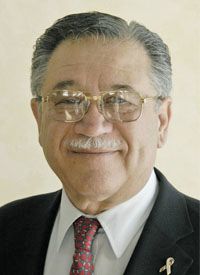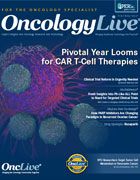Unraveling Neuroendocrine Tumors: Clinician Reflects on 60 Years of Discovery
Richard R.P. Warner, MD, discusses the key learnings and insights of 60 years of studying, diagnosing, and treating patients with neuroendocrine tumors and carcinoid syndrome.
Richard R.P. Warner, MD, neuroendocrine cancer clinician at The Mount Sinai Hospital

Richard R.P. Warner, MD
The Early Years: Piecing Together Evidence
At age 89, I could probably earn the Guinness World Record for the oldest neuroendocrine cancer clinician in the United States, and perhaps even the world. I retired from clinical practice at The Mount Sinai Hospital in New York City in November 2016 to focus on research, lecturing, and patient advocacy. At this interesting point in my career, I am taking time to reflect on the more than 60 years I’ve spent studying, diagnosing, and treating patients with neuroendocrine tumors and carcinoid syndrome. I think it would be valuable to share the key learnings and insights that have built my legacy within this important field.During my internal medicine internship and residency in the early 1950s, a subspecialty in oncology was not yet recognized by a certifying board. Therefore, despite my interest in the eld, I chose to pursue a gastroenterology fellowship in 1954 and read everything in the literature that had any bearing on gastroenterology. I was impressed by an article in the American Heart Journal that mentioned a new syndrome marked by diarrhea and facial flushing, which was associated with little tumors (carcinoids) in the small intestine that had spread to the liver and with prominent right-sided heart valve lesions. This became known as "carcinoid syndrome."
Having completed 1 year of gastroenterology training, I was named chief of gastroenterology for a major hospital while serving in the Air Force Medical Corps during the Korean War in 1955. It was during this time that I encountered a patient with undiagnosed debilitating diarrhea and flushing, and I remembered the article that established carcinoid syndrome as an entity. The case appeared similar, but did not present with a small bowel carcinoid.
My first instinct was to investigate it further, so I went to Oklahoma City to request that this patient’s previous healthcare providers retrieve a lung specimen that had been resected 8 years prior. Keep in mind that at this time, long-term survival of lung cancer was particularly uncommon. After much persuasion, the archived resected lung specimen was retrieved, and I sent it to my pathologist at Mount Sinai for reevaluation. It turns out that it was not adenocarcinoma of the lung, but rather what was designated at that time to be a “bronchial adenoma,” carcinoid type. Hence, I was able to con rm my diagnosis of carcinoid syndrome, interestingly occurring from a lung carcinoid instead of an intestinal carcinoid.
I wrote up the case when I returned to Mount Sinai in 1956 and presented it to my chief, who was also editor of the American Journal of Medicine. He told me about another case that was puzzling other physicians in the hospital and asked me to examine that patient. I performed the examination, and it appeared the patient also had carcinoid syndrome. I requested a 5-HIAA urine test to con rm the diagnosis. When serotonin is metabolized in the body, it becomes 5-HIAA, and when a patient has carcinoid syndrome, he or she tends to have high levels of 5-HIAA in the blood and in the urine, which is a key signal for diagnosis.
At that time, there was no commercial 5-HIAA test available, so I took matters into my own hands, and went directly to the National Institutes of Health to receive a quick tutelage on how to conduct the assay myself. When I returned and tested the patient, his levels were very high, which confirmed a carcinoid syndrome diagnosis.
While trying to treat these patients, my intrigue and interest continued to grow and I knew wholeheartedly I wanted to continue to focus more time on learning the intricacies of this disease. I wrote up these 2 carcinoid syndrome cases, and they were published in the American Journal of Medicine in 1958. The article represented the first cases of carcinoid syndrome reported as occurring from lung carcinoids. At present, 28% to 30% of all carcinoids arise in the lung; however, not all of these tumors develop into carcinoid syndrome since the majority of all carcinoids are endocrinologically nonfunctioning.
I continued to take a strong interest in this rare disease and collected more cases over the years, progressively becoming an expert in this field. Zollinger-Ellison syndrome was recognized clinically around the same time as carcinoid syndrome, and the similarity between these conditions led clinicians to believe both diseases were part of the same family.
A Challenging Diagnosis
The concept of a diffuse neuroendocrine cell system eventually solidified the recognition of neuroendocrine tumors and additional subtypes emerged. Since these tumors are not restricted to 1 organ or 1 place in the body, the endocrine cells from which the neuroendocrine tumors develop are widely dispersed and scattered among healthy cells and various organs.It is important for all clinicians to know that the physical symptoms of carcinoid syndrome may vary tremendously depending on where the neuroendocrine tumors develop and metastasize. Carcinoid syndrome is a concurrence of symptoms and findings that together make up the disease. A patient has to have a neuroendocrine tumor and it has to be producing hormone products—predominantly serotonin—to be a carcinoid. The most common symptoms are diarrhea and facial flushing, but can also include asthma, bronchospasm, fever with episodes, abdominal pain, enlarged liver due to invasion by a tumor, weakness, weight loss, and predominantly right-sided heart valve lesions. Heart failure can even be the first symptom.
Because many of these symptoms are present in more common diseases, many clinicians do not think of carcinoid syndrome or test for it when they initially encounter it. As medical students, we are taught that when you hear hoof beats, think of horses. In other words, consider common diseases as more likely if you see common symptoms. However, we cannot always assume the hoof beats are produced by a horse; there may occasionally be a zebra present. Therefore, we have to include the rare disease in our differential diagnosis.
A Multidisciplinary Approach and Resources
Unfortunately, the great variety of common symptoms that a carcinoid can produce often causes a long delay in diagnosis—on average, approximately 5 to 10 years. Greater awareness of this rare diagnosis is critical. I encourage all clinicians to be aware of the existence of this uncommon disease and to consider it in their differential diagnosis if something else has not been definitively proved. My motto is: “If you don’t suspect it, you can’t detect it.”If in doubt, a diagnosis of carcinoid syndrome should be made by an expert due to the wide variety of tests that might be needed to confirm it. Additionally, the numerous treatment options that depend on the location, extent, and degree of endocrine activity could overwhelm a sole practitioner. I recommend that clinicians seek out a neuroendocrine cancer expert to work collaboratively to diagnose and treat their patients with this disease.
I often seek assistance from other specialists, recognizing that no one doctor, including myself, can have maximum knowledge of all available modalities for diagnosis and treatment. For example, I seek the help of a radiologist or nuclear medicine specialist for scanning, imaging interpretation, and treatment. I ask for surgical and neurology consults in many cases and, similarly, the assistance of other specialists when appropriate. Every case also needs a knowledgeable pathologist. Multiple disciplines are necessary in almost all cases, and consultation goes hand-in-hand with the management of the patient by the specialists and the general practitioner or oncologist.
Today, there are many sources of information that clinicians treating patients with neuroendocrine tumors and carcinoid syndrome, or just looking to learn more, can leverage (Table). The North American Neuroendocrine Tumor Society is an excellent resource. I helped create this organization in 2006 with the purpose of disseminating knowledge in the eld and encouraging research and specialization by younger physicians.
Treating This Malignant Cancer
This organization and its counterpart, the European Neuroendocrine Tumor Society, are both growing in size, which speaks well for expectations in the future. Other helpful resources include the Carcinoid Cancer Foundation and the Neuroendocrine Cancer Awareness Network website. There are also support groups in almost every state for patient education.When Siegfried Oberndorfer, the eminent German pathologist, first described lesions in the gut similar to carcinoma and coined the term "carcinoid" in 1907, the tumors were thought to be benign and very rare. For decades, cases of neuroendocrine tumors were not aggressively pursued and efforts to improve diagnostic tools and treatments were not considered high priority.
Today, we know neuroendocrine tumors are a malignant, but often a very slow-growing, cancer. The only cure is complete surgical resection of the disease, so it is important to identify the site of origin and type of carcinoid early. When there is metastasis and complete removal of the tumors is not possible, prolongation of survival is still very likely with other forms and combinations of treatments.
Table. Neuroendocrine Tumor Resources
Growing Awareness and Increasing Prevalence
During the course of my career, I have seen tremendous growth in specialized testing and advanced treatments for neuroendocrine tumors and carcinoid syndrome. I established and directed a laboratory at Mount Sinai from 1958 to 1998 to conduct the 5-HIAA test and assays for blood serotonin levels, tryptophan, histamine, and other related substances. However, we closed the lab when these diagnostic tests became commercially available.The first treatment advance in the 1980s was the introduction of the somatostatin analogues, octreotide and lanreotide. Thereafter, many new advancements have been developed, particularly in the past 5 to 10 years. These have included improved imaging with MRI, CT, endoscopy, ultrasound, and isotope scans (eg, octreoscan, Gallium-68, and others), targeted chemotherapy, improved surgery, liver transplant, radioisotope treatment, and, most recently, serotonin synthesis inhibition by tryptophan hydroxylase inhibitor. Patients are beginning to be diagnosed earlier and live longer with combinations of these new treatments. Furthermore, as these developments have emerged, more and more cases are being diagnosed.The incidence of neuroendocrine tumors and related diseases has increased tremendously during the last 3 to 4 decades. The number of cases reported each year has increased more than 5-fold. There is reason to believe that, as awareness grows, so will the number of cases. Therefore, it behooves most practitioners to have a greater understanding and awareness of this disease and to more often consider it in a differential diagnoses. We are still missing cases that should be diagnosed, or at least diagnosed sooner.
A better and wider recognition of this group of diseases promises to lead to further progress in terms of the development of more effective and sophisticated treatments. For finding therapy, we no longer have to ride on the coattails of more common cancers, as treatments are now being researched specifically for neuroendocrine tumors, particularly in the areas of immunological mechanisms and genomic determinations. I predict that progress will be more rapid in the future and look forward to watching the next generation of clinicians carry forward this important work.




